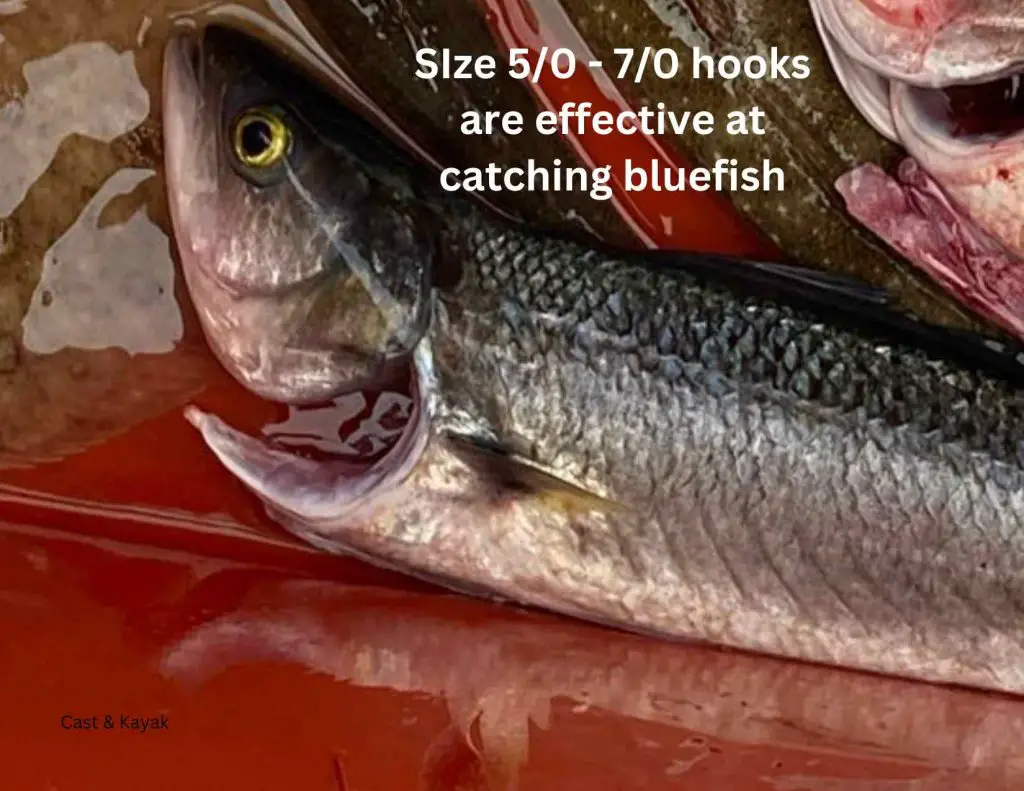
Having a bluefish (or tailor as they’re known elsewhere) take a big strike of your bait only to be lost because the hook didn’t set properly is one of the most frustrating saltwater fishing experiences out there.
There’s the initial adrenaline and rush, swiftly followed by a big anti-climax!
The reason this happens with bluefish is often to do with hook size.
Either your bluefish hook is too small or too big.
So what size hook for bluefish should you use?
Use a hook between a 5/0 and 7/0 size for bluefish. The larger hook size tends to work better when using chunks of bait, and has less chance of being completely swallowed by the fish. Circle or J hooks both work well, and you should use wire or heavy mono leader to prevent the bluefish from biting through.
Choosing the right size hook can lead to more successful hook-ups for bluefish, and avoid the fish shredding through your line.
Want to know how to catch bluefish from the pier or surf? Click here for full guide.
The right size hook for bluefish
You want to choose a hook size that gives the bluefish enough space to strike and attack the bait and get hooked up without the fish’s teeth scraping against the line.
A size 5/0-7/0 hook should be able to hold the bait well, whilst still giving room to hoo-up the bluey safely in the side of the mouth.
Bluefish are extremely aggressive predators for their size and have sharp teeth that can cut through fishing line pretty easily.
When a bluefish strikes a bait they tend to gnash and shake their head with the bait in their mouths from side to side.
Learn what attracts bluefish here – click!
Bluefish bite-offs and breaks tend to be caused by the fish’s teeth shearing against the line as they are shaking their heads.
If you’re using a light mono or braid then it’s possible the bluefish will damage the line when striking.
Or when jumping out of the water and shaking its head to try to free itself from the hook.
What size J-hook or circle-hook for bluefish?
Choosing the right hook that sets quickly can help here.
And there are different schools of thought about which is the right hook to use – either a J-hook or a circle-hook.
Generally, both hooks work in similar sizes for catching bluefish.
But the best advice I’ve heard which I’ve not seen others talk about too much yet, is to experiment with your hook types!
This is fishing after all.
And I’m always experimenting with my fishing.
Trying new colours, lure shapes, baits, hook sizes, leader lines etc. etc.
All to get the fish to bite and to stay on.
And this advice is no less true for picking the right hook size for bluefish.
Let’s have a look at the two hook types and their pros and cons for catching bluefish.

Circle hooks for bluefish
Pros
- Circle hooks tend to hold live bait really well, which can help lead to more successful hook-ups
- Circle hooks are also ‘self-setting’. The way the hook is designed and rigged up means that when it’s put under tension from a biting fish, the hook rotates and hooks the fish up almost automatically.
Cons
- Some say that because circle hooks do this ‘self-setting’ they actually try and set too quickly for a bluefish strike. This means the fish misses the hook when thrashing the bait around and doesn’t get snagged on the barb.
J-hooks for bluefish
Pros
- Avoids the issues mentioned above about missing the hook-set due to the circle hoo’s ‘self-setting’ trait.
Cons
- You have to really pay attention to your bait, because you’ll need to help set the hook when a bluefish bites. People often do this too early before the fish really has the bait in its mouth, and miss the hook set.
Bonus tip for choosing the right type and size hooks for bluefish
The final tip that I want to offer you is my experience using ganged hooks.
Again, I would experiment with sizes between 2/0-5/0 gang hooks for catching bluefish.
Ganged hooks tend to be three J-hooks all linked to each other via the eye of the hook.
Using ganged hooks for bluefish is a great idea because there is much more length of hooks before the bluefish has a chance to serrate the line and break it.
As I said before, bluefish shake and thrash the bait when they strike, and ganged hooks give you more chance to hook up a bluefish when it is displaying this striking behaviour.
If you’re not using ganged hooks, your real protection for those incredibly sharp bluefish teeth comes from using a stronger leader line to attach the right size hook for bluefish onto.
